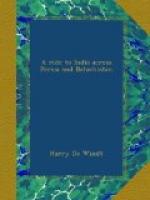ISPAHAN—SHIRAZ.
The seven telegraph-stations, in charge of Europeans, between Teheran and Bushire, may be called the oases of Persia to the weary traveller from Resht to the Persian Gulf. He is sure, at any of these, of a hearty welcome, a comfortable bedroom, and a well-cooked dinner from the good Samaritan in charge. The latter is generally the best of company, full of anecdote and information about the country, and, necessarily, well posted in the latest news from Europe, from the last Parliamentary debate to the winner of the Derby. These officials are usually ci-devant non-commissioned officers of Royal Engineers. Some are married, for the life is a lonely one, and three or four months often elapse without personal communication with the outer world, except on the wires. By this means, when the latter are not in public use, the telegraphist can lighten his weary hours by animated conversation with his colleague two or three hundred miles away on congenial topics—the state of the weather, rate of exchange, chances of promotion, and so on. Living, moreover, at most of the stations is good and cheap; there is plenty of sport; and if a young unmarried man only keeps clear of the attractions of the fair sex, he soon makes friends among the natives. Love intrigues are dangerous in Persia. They once led to the massacre of the whole of the Russian Legation at Teheran.
Ispahan is a city of ruins. A Persian will tell you, with pride, that it is nearly fifteen miles in circumference, but a third of this consists of heaps of stones, with merely the foundation-lines around to show that they were once palaces or more modest habitations. Chardin the traveller, writing in A.D. 1667, gives the population of Ispahan at considerably over a million, but it does not now exceed fifty thousand, including the suburb of Djulfa. The Madrassa, or College, the governor’s palace, and “Chil Situn,” or “Palace of the Forty Pillars,” are the only buildings that still retain some traces of their former glory. Pertaining to the former is a dome of the most exquisite tile-work, which, partly broken away, discloses the mud underneath; a pair of massive gates of solid silver, beautifully carved and embossed; a large shady and well-kept garden in the centre of the Madrassa, with huge marble tanks of water, surrounded by an oblong arcade of students’ rooms—sixty queer little boxes about ten feet by six, their walls covered with arabesques of great beauty. These are still to be seen—and remembered. With the exception of the “Maidan Shah,” or “Square of the King”—a large open space in the centre of the city, surrounded by modern two-storied houses—the streets of Ispahan are narrow, dirty, and ill-paved, and its bazaar, which adjoins the Maidan Shah, very inferior in every way to those of Teheran or Shiraz.




